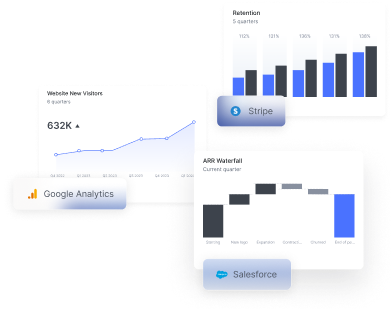Unleashing the Potential of Advanced Analytics in Salesforce: A Streamlined Approach

VP Data & Product Strategy at Sightfull
CRM analytics in general, and Salesforce analytics in particular, is a familiar pain point for Sales, Revenue, and Data teams alike. Too familiar. As is often the case, we know where we are (point A) and where we want to be (point B), but the question is: how do we get there?
In this post, we'll explore Points A and B and the path between them to share our perspectives on how embedding advanced analytics in Salesforce helps organizations push their CRM analytics to the next level and simplify their toolkit at the same time.

Point A: The Problem – Limited Salesforce Analytics Leads to a Proliferation of Tools
Salesforce is the world's most popular CRM solution, adopted by sales teams across industries and regions. However, native analytics and dashboarding in Salesforce are notoriously limited, especially in areas like historical analysis (trends over time), snapshotting, advanced analytics and modeling, customized visualization, and overall user-friendliness.
Equally important, sales data alone is insufficient for a holistic understanding of your GTM efforts. To achieve this, you need to integrate information from marketing campaigns, outbound sequences, customer engagements, and finance data. Connecting these additional data sources to Salesforce is a complex data infrastructure and modeling exercise. Organizations typically only attempt this integration when they have a pressing operational need, not to enable more analytics. Over time, this introduces a ceiling to how good the analytics in Salesforce can be.
As a result, organizations turn to other tools. These include specialized point solutions for specific workflows (like Clari for forecasting or Atrium for rep coaching), complex data stacks (ETLs, transformations, analytics code, and visualization tools), or modern analytics tools, like Sightfull 😉.
The end result is scattered analytics and reporting, with the most important insights residing outside Salesforce. Often, the proliferation of tools leads to analytics losing their impact. Effective, actionable insights and reports need to exist where the operators work; otherwise, they’ll be ignored or sidelined (also known as the monthly “Marketing - Sales Review”).
Create a single source of truth for your business.

Point B: The Desired End State – Consolidating Data Sources and Stakeholders
The most common analytics challenges we hear from clients and partners revolve around consolidation: consolidating data, consolidating the sales team, and consolidating the broader organization. Here’s what this means:
- Consolidating data: Leverage all available data to provide full and accurate context (including marketing, outbound, engagements, product, and CS).
- Consolidating sales teams: Ensure everyone on the team, from the VP of Sales to the BDR, looks at the same information in the same place.
- Aligning the sales team with the broader organization: Align the organization around a common source of truth. If management measures the organization on ARR and Net Retention, the sales team can’t focus on 1st-year ACV just because that’s what the Salesforce admin could calculate.
To make this ideal end state effective, advanced analytics cannot be scattered across tools and dashboards. To be part of the daily workflows and decision-making of sales operators and leaders, advanced analytics insights must live inside the operational system (i.e., Salesforce), providing context and tying directly to next steps.
How to Get There – Embedded Analytics in the CRM
The journey from A to B requires bridging the need for a sophisticated analytics engine with the necessity of keeping things streamlined and minimizing tool proliferation. It’s about having the GTM analytics cake and eating it too.
Embedded analytics helps resolve this conflict. The guiding principle here is to use a purpose-built tool to do the heavy lifting of analytics and embed it natively into Salesforce.
On the analytics end: Choose a tool that can consolidate multiple data sources, automate advanced calculations, handle point-in-time and historical trend analysis, integrate GenAI interactions, and provide a business user-friendly interface.
On the Salesforce side: Ensure this wealth of data can be embedded back into Salesforce, making it fully accessible. There are two levels to consider:
- General Analysis: Powerful dashboards showing analysis across objects and entities to monitor performance and track trends.
- Context-Specific Analysis: Rich, multi-source insights about specific accounts, opportunities, or salespersons, embedded within the relevant Salesforce pages.
Finally, because this wouldn’t be content marketing if I didn’t mention it, we’re very proud of how Sightfull delivers on both aspects of this problem.
- As an analytics engine, it allows organizations to consolidate diverse data sources into one semantic layer and build powerful metrics on top of it. It embeds context-aware GenAI that understands the business meaning of the metrics it interacts with.
- On the Salesforce side, Sightfull provides intelligent integrations directly into your system. You can display advanced analysis of your entire data model (from multiple sources!) in a general Sightfull tab, and embed relevant metrics in the accounts, opportunity, and user pages to provide sales operators with relevant, actionable insights on specific entities.
By embedding advanced analytics in Salesforce, organizations can simplify their toolset, unify their data sources, and bring crucial insights directly into their workflow. This integration ensures that valuable information is always at hand, driving better decision-making and operational efficiency.
Interested in transforming your Salesforce experience?
Learn more about how Sightfull can help you achieve your analytics goals.
Embedded Salesforce Analytics
A comprehensive SaaS reports' library that effortlessly tracks and reports historical data out-of-the-box.
Now, seamlessly integrated into your Salesforce platform.



















